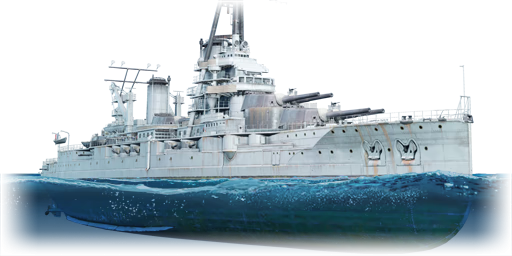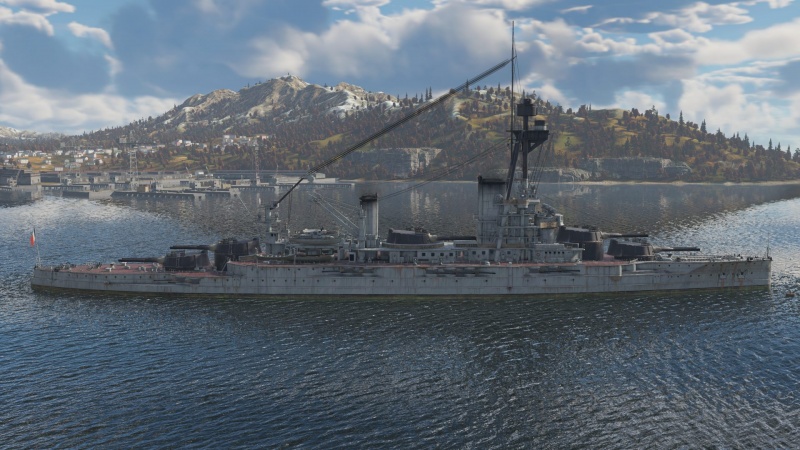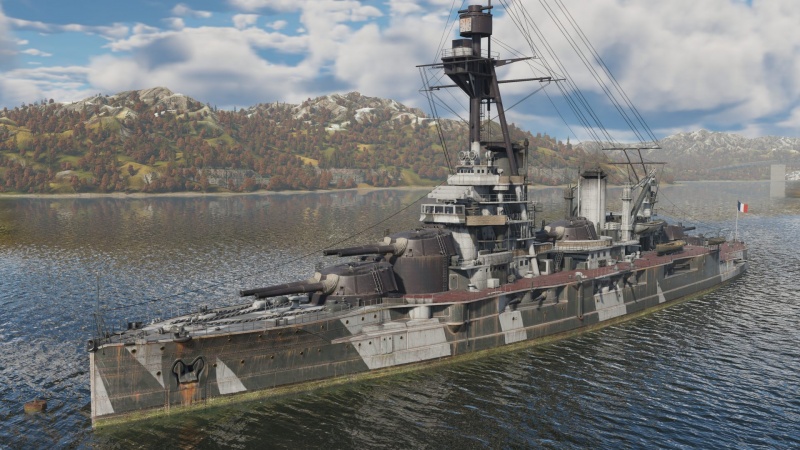Difference between revisions of "Bretagne"
(→Description) |
m (added mobility section) (Tag: Visual edit) |
||
| Line 19: | Line 19: | ||
=== Mobility === | === Mobility === | ||
| − | + | Maximum Speed in Arcade Battles (km/h) Foward is 46. Reverse 29. | |
| − | + | ||
| − | + | Maximum Speed in Realistic/Simulator Battles (km/h) Foward is 40. Reverse 25. | |
{{NavalMobility}} | {{NavalMobility}} | ||
| Line 113: | Line 113: | ||
* ''topic on the official game forum;'' | * ''topic on the official game forum;'' | ||
* ''other literature.'' --> | * ''other literature.'' --> | ||
| + | |||
* [[wikipedia:French battleship Bretagne|[Wikipedia] French battleship Bretagne]] | * [[wikipedia:French battleship Bretagne|[Wikipedia] French battleship Bretagne]] | ||
* [https://uboat.net/allies/warships/ship/5968.html <nowiki>[uboat.net]</nowiki> FR Bretagne] | * [https://uboat.net/allies/warships/ship/5968.html <nowiki>[uboat.net]</nowiki> FR Bretagne] | ||
Latest revision as of 23:54, 18 November 2024
Contents
Description
Bretagne was a French super-dreadnought, lead ship of her class, launched in April 1913. Due to the constraints of the French shipyards, her length and displacement remained almost unchanged compared to her predecessors of the Courbet class. During World War One, she was delegated to blockading the deployment of German and Austro-Hungarian submarines. During the interwar period, Bretagne underwent several very extensive modernizations, including updating fire control systems, replacing an outdated mast with a tripod, and strengthening anti-air defence.
With the outbreak of World War Two, the battleship was based in Toulon and participated in the naval blockade of Germany. In March 1940, she transported part of France's gold reserves to Halifax. At the time of the Invasion of France, she was stationed in Mers-el-Kébir. After the surrender of France, the British command decided to launch an attack on Mers-el-Kebir in order to prevent French ships from falling into German hands. On July 3, during Operation Catapult, the fleet stationed in harbour came under fire from the battleships HMS Valiant and HMS Resolution and the battlecruiser HMS Hood along with escort vessels. Bretagne received several hits from 381 mm shells, leading to an explosion and sinking which killed 1,012 crew members. In 1942, attempts were made to raise the battleship's hull for cutting, but they were stopped after an explosion occurred on board. In 1952, the hull was finally raised and by 1954 cut for scrap.
The Bretagne was introduced in Update "Alpha Strike" in her 1925 refit. She plays like a typical WW1-era dreadnought, being best used in a second line, picking off targets with her multiple large-calibre guns. Her mediocre armour, little mobility, and next to no anti-air defenses make it difficult for her to compete for capture points or slug out against vessels at higher BRs.
General info
Survivability and armour
Talk about the vehicle's armour. Note the most well-defended and most vulnerable zones, e.g. the ammo magazine. Evaluate the composition of components and assemblies responsible for movement and manoeuvrability. Evaluate the survivability of the primary and secondary armaments separately. Don't forget to mention the size of the crew, which plays an important role in fleet mechanics. Save tips on preserving survivability for the "Usage in battles" section. If necessary, use a graphical template to show the most well-protected or most vulnerable points in the armour.
Mobility
Maximum Speed in Arcade Battles (km/h) Foward is 46. Reverse 29.
Maximum Speed in Realistic/Simulator Battles (km/h) Foward is 40. Reverse 25.
| Mobility Characteristics | |||
|---|---|---|---|
| Game Mode | Upgrade Status | Maximum Speed (km/h) | |
| Forward | Reverse | ||
| AB | |||
| Upgraded | 46 | 29 | |
| RB/SB | |||
| Upgraded | 40 | 25 | |
Modifications and economy
Armament
Primary armament
Provide information about the characteristics of the primary armament. Evaluate their efficacy in battle based on their reload speed, ballistics and the capacity of their shells. Add a link to the main article about the weapon: {{main|Weapon name (calibre)}}. Broadly describe the ammunition available for the primary armament, and provide recommendations on how to use it and which ammunition to choose.
| Penetration statistics | |||||||
|---|---|---|---|---|---|---|---|
| Ammunition | Type of warhead |
Penetration @ 0° Angle of Attack (mm) | |||||
| 1,000 m | 2,500 m | 5,000 m | 7,500 m | 10,000 m | 15,000 m | ||
| OEA Mle 1926 HE | HE | 68 | 68 | 68 | 68 | 68 | 68 |
| OPF Mle 1912 APC | APC | 472 | 424 | 355 | 301 | 258 | 203 |
| OPF Mle 1921 APCBC | APCBC | 493 | 457 | 403 | 359 | 321 | 267 |
| Shell details | ||||||||||||
|---|---|---|---|---|---|---|---|---|---|---|---|---|
| Ammunition | Type of warhead |
Velocity (m/s) |
Projectile mass (kg) |
Fuse delay (s) |
Fuse sensitivity (mm) |
Explosive mass (TNT equivalent) (kg) |
Ricochet | |||||
| 0% | 50% | 100% | ||||||||||
| OEA Mle 1926 HE | HE | 855 | 382 | 0 | 0.1 | 34.4 | 79° | 80° | 81° | |||
| OPF Mle 1912 APC | APC | 795 | 540 | 0.025 | 20 | 24.18 | 48° | 63° | 71° | |||
| OPF Mle 1921 APCBC | APCBC | 794 | 555 | 0.025 | 20 | 24.18 | 48° | 63° | 71° | |||
Secondary armament
Some ships are fitted with weapons of various calibres. Secondary armaments are defined as weapons chosen with the control Select secondary weapon. Evaluate the secondary armaments and give advice on how to use them. Describe the ammunition available for the secondary armament. Provide recommendations on how to use them and which ammunition to choose. Remember that any anti-air armament, even heavy calibre weapons, belong in the next section. If there is no secondary armament, remove this section.
| Penetration statistics | |||||||
|---|---|---|---|---|---|---|---|
| Ammunition | Type of warhead |
Penetration @ 0° Angle of Attack (mm) | |||||
| 1,000 m | 2,500 m | 5,000 m | 7,500 m | 10,000 m | 15,000 m | ||
| OEA Mle 1919 HE | HE | 36 | 36 | 36 | 36 | 36 | 36 |
| OPF Mle 1910 SAP | Common | 67 | 49 | 34 | 34 | 34 | 34 |
| OPF Mle 1921 SAPBC | SAPBC | 73 | 62 | 47 | 35 | 34 | 34 |
| Shell details | ||||||||||||
|---|---|---|---|---|---|---|---|---|---|---|---|---|
| Ammunition | Type of warhead |
Velocity (m/s) |
Projectile mass (kg) |
Fuse delay (s) |
Fuse sensitivity (mm) |
Explosive mass (TNT equivalent) (kg) |
Ricochet | |||||
| 0% | 50% | 100% | ||||||||||
| OEA Mle 1919 HE | HE | 840 | 31.5 | 0 | 0.1 | 3.41 | 79° | 80° | 81° | |||
| OPF Mle 1910 SAP | Common | 830 | 36.5 | 0.05 | 6 | 2.93 | 47° | 60° | 65° | |||
| OPF Mle 1921 SAPBC | SAPBC | 790 | 39.5 | 0.05 | 6 | 2.93 | 48° | 63° | 71° | |||
Anti-aircraft armament
An important part of the ship's armament responsible for air defence. Anti-aircraft armament is defined by the weapon chosen with the control Select anti-aircraft weapons. Talk about the ship's anti-air cannons and machine guns, the number of guns and their positions, their effective range, and about their overall effectiveness – including against surface targets. If there are no anti-aircraft armaments, remove this section.
Additional armament
Describe the available additional armaments of the ship: depth charges, mines, torpedoes. Talk about their positions, available ammunition and launch features such as dead zones of torpedoes. If there is no additional armament, remove this section.
Usage in battles
Describe the technique of using this ship, the characteristics of her use in a team and tips on strategy. Abstain from writing an entire guide – don't try to provide a single point of view, but give the reader food for thought. Talk about the most dangerous opponents for this vehicle and provide recommendations on fighting them. If necessary, note the specifics of playing with this vehicle in various modes (AB, RB, SB).
Pros and cons
Summarise and briefly evaluate the vehicle in terms of its characteristics and combat effectiveness. Mark its pros and cons in the bulleted list. Try not to use more than 6 points for each of the characteristics. Avoid using categorical definitions such as "bad", "good" and the like - use substitutions with softer forms such as "inadequate" and "effective".
Pros:
Cons:
History
By 1910, the previously competitive French Navy was considerably behind major naval powers such as Britain, Germany & the USA in terms of capital ships, having not yet laid down a single dreadnought type warship whilst the Kaiserliche Marine had built 8 dreadnoughts and a battlecruiser, the United States Navy had built 6 dreadnoughts and the Royal Navy had built 10 dreadnoughts and 5 battlecruisers, and that's ignoring the additional capital ships the nations also had under construction at the time. Even the Imperial Russian Navy had four of its first dreadnought class under construction at the time and Brazil owned two dreadnoughts which Britain had finished construction of that same year. It was only in late 1910 that the first of the 4 French Courbet class dreadnoughts had been laid down, meanwhile other major powers were continually producing and planning yet more capital ships.
In an attempt to reverse France's current naval inferiority, the government authorised an ambitious naval program in March 1912, calling for a force of 28 modern battleships to be completed within the next 8 years, starting with the new Bretagne class of 3 super-dreadnoughts, all laid down that same year.
To compete with the designs of contemporary battleships, the Bretagne class required 340 mm guns over the prior 305 mm of the Courbet class, but within a hull based on that of the Courbet so that it would still fit France's limited dockyards, necessitating 5 turrets rather than the 6 of the Courbet. However, the Bretagne placed all of its main turrets on the centreline, retaining the 10 gun broadside of the Courbet, which used two wing-turrets.
The three ships of the class were completed just prior to the outbreak of the First World War, though a fourth ship ordered by Greece was never completed. The ships spent the majority of the war in port while guarding the Adriatic from potential Austro-Hungarian incursions, as well as being used to intimidate Greece, which was leaning toward supporting Germany. Through the interwar years, the three ships received sporadic refits and conducted training cruises. During the Spanish Civil War, Bretagne & Provence joined non-intervention patrols off the Spanish coast.
Following the start of the Second World War, the ships initially didn't see any action outside of escorting several convoys. However, after the Fall of France, Force H of the Royal Navy accosted the majority of the French Navy in the harbour of Mers-el-Kébir in July 1940, delivering an ultimatum which suggested various ways for the French fleet to be interned by or integrated with the Royal Navy to prevent the Axis from having any chance of seizing the ships and overwhelming the British Mediterranean Fleet. Failure to comply with the ultimatum would result in Force H attempting to destroy the French Fleet in the port, which included Bretagne and Provence.
After several hours of negotiations, no agreement was reached and the warships of Force H initiated hostilities upon the French fleet. Within minutes, Bretagne was struck by two 381 mm shells from the third salvo of HMS Hood, HMS Resolution & HMS Valiant, one blasting a hole in the hull with a fiery explosion, causing flooding, and the other destroying the centre engine room. 7 minutes later, another two 381 mm shells hit, which was shortly followed by a catastrophic ammunition detonation that rocked the ship, causing it to roll over and sink. Meanwhile, Provence had begun returning fire on Force H about 90 seconds after the British opened fire, but scored no hits and was then subsequently hit by several 381 mm shells, igniting blazing fires onboard and tearing open the hull, allowing vast quantities of water to flood in, eventually sinking the ship to the bottom of the harbour.
Following the attack, though Bretagne was a lost cause, Provence was raised from the seabed. The ship was somewhat repaired and transferred to Toulon, where it stayed until being scuttled in 1942 to keep the Germans from using it.
Meanwhile, whilst all that had been going on, Lorraine had been interned in Alexandria since the Fall of France. In 1942, the crew of the ship decided to join the navy of Free France and the ship served as a training vessel though 1943. The ship then received a major refit before participating in Operation Dragoon of 1944 as an artillery support ship during the landings. The last action of the ship during war was the bombardment of German forts in northern France in March 1945.
Following the war, the Lorraine became a gunnery training ship and then a barracks ship before being decommissioned in 1953 and sold to scrappers. What was left of Bretagne was raised and scrapped in 1952, while the hulk of Provence was raised and scrapped in 1949.
Media
Excellent additions to the article would be video guides, screenshots from the game, and photos.
See also
Links to articles on the War Thunder Wiki that you think will be useful for the reader, for example:
- reference to the series of the ship;
- links to approximate analogues of other nations and research trees.
External links
- [Wikipedia] French battleship Bretagne
- [uboat.net] FR Bretagne
- [NAVYPEDIA] BRETAGNE battleships (1915 - 1916)
| Arsenal de Brest | |
|---|---|
| Avisos | |
| Arras-class | Arras |
| Light Cruisers | |
| Duguay-Trouin-class | Duguay-Trouin · Primauguet |
| Heavy Cruisers | |
| Suffren-class | Colbert · Dupleix |
| Battleships | |
| Bretagne-class | Bretagne |
| Dunkerque-class | Dunkerque |
| France battleships | |
|---|---|
| Courbet-class | Courbet · Paris |
| Bretagne-class | Bretagne · Lorraine |
| Dunkerque-class | Dunkerque |








